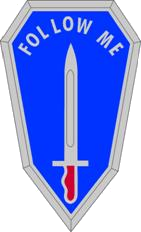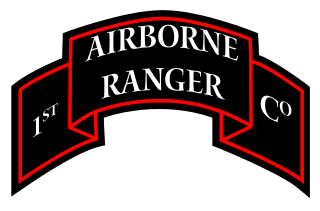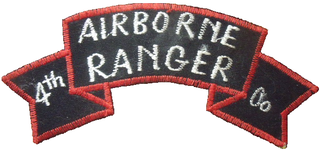
United States Army Rangers, according to the US Army's definition, are personnel, past or present, in any unit that has the official designation of "Ranger". The term is commonly used to include graduates of the US Army Ranger School, even if they have never served in a "Ranger" unit.

The 75th Ranger Regiment, also known as Army Rangers, is the U.S. Army's premier light infantry unit and special operations force within the United States Army Special Operations Command. The regiment is headquartered at Fort Benning, Georgia and is composed of a regimental headquarters company, a military intelligence battalion, a special troops battalion, and three Ranger battalions.

Fort Benning is a United States Army post straddling the Alabama–Georgia border next to Columbus, Georgia. Fort Benning supports more than 120,000 active-duty military, family members, reserve component soldiers, retirees and civilian employees on a daily basis. It is a power projection platform, and possesses the capability to deploy combat-ready forces by air, rail, and highway. Fort Benning is the home of the United States Army Maneuver Center of Excellence, the United States Army Armor School, United States Army Infantry School, the Western Hemisphere Institute for Security Cooperation, elements of the 75th Ranger Regiment, the 1st Security Force Assistance Brigade, and other tenant units.

Light infantry is a designation applied to certain types of foot soldiers (infantry) throughout history, typically having lighter equipment or armament or a more mobile or fluid function than other types of infantry, such as heavy infantry or line infantry. Historically, light infantry often fought as scouts, raiders, and skirmishers; soldiers who fight in a loose formation ahead of the main army to harass, delay, disrupt supply lines, engage the enemy’s own skirmishing forces, and generally "soften up" an enemy before the main battle. Light infantrymen were also often responsible for screening the main body of a military formation. Post-World War II, the term "light infantry" evolved, and now generally refers to rapid-deployment units that specifically emphasize speed and mobility over armor and firepower. Some units or battalions that historically held a skirmishing role have kept their designation "light infantry" for the sake of tradition.

A long-range reconnaissance patrol, or LRRP, is a small, well-armed reconnaissance team that patrols deep in enemy-held territory.

In military organizations, a pathfinder is a specialized soldier inserted or dropped into place in order to set up and operate drop zones, pickup zones, and helicopter landing sites for airborne operations, air resupply operations, or other air operations in support of the ground unit commander. Pathfinders first appeared in World War II, where they served with distinction, and continue to serve an important role in today's modern armed forces, providing commanders with the option of flexibly employing air assets.

The 187th Airborne Infantry Regiment (Rakkasans) is a regiment of the 101st Airborne Division.

The United States Army Airborne School – widely known as Jump School – conducts the basic paratrooper training for the United States Armed Forces. It is operated by the 1st Battalion (Airborne), 507th Infantry, United States Army Infantry School, Fort Benning, Georgia. The Airborne School conducts the Basic Airborne Course, which is open to troops from all branches of the United States Department of Defense, Reserve Officer Training Corps, and allied military personnel.

The 3rd Ranger Battalion, currently based at Fort Benning, Georgia, is the third of three Ranger Battalions belonging to the United States Army's 75th Ranger Regiment.

The United States Army Infantry School is a school located at Fort Benning, Georgia that is dedicated to training infantrymen for service in the United States Army.

Company F, 425th Infantry was a long range surveillance unit of the Michigan National Guard that was inactivated on 12 June 2011. The company came into being in the mid-1960s when the 1st Battalion (Airborne), 225th Infantry was reflagged as Companies E and F (Ranger), 425th Infantry, and organized as Ranger companies. During this period these two companies were assigned to division and higher level commands to perform long range reconnaissance patrol missions, as opposed to the Ranger companies of today which comprise the four battalions of the 75th Ranger Regiment. According to the United States Army Center of Military History, it was reorganized and redesignated as the 425th Infantry Detachment (LRS) effective 1 September 2008 and was relocated from the State of Michigan Pontiac Armory to the Selfridge Air National Guard Base near Mount Clemens, 15 miles northeast of Detroit.
The Korean War Ranger Companies were the United States Army Rangers of the Korean War.

The Infantry Branch is a branch of the United States Army first established in 1775.

The 58th Infantry Regiment is a regiment of the United States Army first established in 1917.

The Eighth Army Ranger Company, also known as the 8213th Army Unit, was a Ranger light infantry company of the United States Army that was active during the Korean War. As a small special forces unit, it specialized in irregular warfare. Intended to combat the North Korean (NK) commandos who had been effective at infiltration and disruption behind United Nations (UN) lines, the Eighth Army Ranger Company was formed at the height of the Battle of Pusan Perimeter in September 1950 and was the first U.S. Army Ranger unit created since World War II. The company went into action as a part of the 25th Infantry Division during the UN advance into North Korea in October and November. It was best known for its defense of Hill 205 against an overwhelming Chinese attack during the Battle of the Ch'ongch'on River which resulted 41 of the 51 Rangers becoming casualties.

The 1st Ranger Infantry Company (Airborne) was a Ranger light infantry company of the United States Army active during the Korean War. As a small special forces unit, it specialized in irregular warfare.

The 2nd Ranger Infantry Company (Airborne) was a Ranger light infantry company of the United States Army active during the Korean War. As a small special operations unit, it specialized in irregular warfare. A segregated unit, all of its personnel, including its officers, were African-Americans.

The 3rd Ranger Infantry Company (Airborne) was a Ranger light infantry company of the United States Army active during the Korean War. As a small special forces unit, it specialized in irregular warfare.

The 4th Ranger Infantry Company (Airborne) was an airborne-trained infantry unit that was part of the United States Army during the Korean War. The 4th Rangers were created as a result of the actions of North Korean Special Forces units such as the KPA's 766th Independent Infantry Regiment that were overrunning Republic of Korea Army (ROK) and United Nations (UN) units. North Korean special units that were trained in the art of unconventional warfare were beating the ROK and UN units that were stationed in South Korea, pushing them back towards the Pusan Perimeter.

The Royal Thai Army Special Warfare Command also known as Pa Wai Airborne is the special forces of the Royal Thai Army. Its headquarters are King Narai Camp in Lopburi.




















